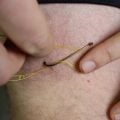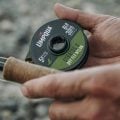How to Tie the Light Cahill Quigley Cripple
Producer: tightlinevideo
This is a Light Cahill version of Bob Quigley’s remarkable fly, the Quigley Cripple. It serves not only as a cripple, but also could be mistaken for an emerger, spinner or maybe even a dun. By changing the color of the materials used, it can be tied to imitate a whole host of mayfly species.
The fly starts with a Lightning Strike DF1 dry fly hook in size 14. Begin by getting the hook firmly secured in the jaws of your tying vise.
For thread, I’ve loaded a shorty Rite Bobbin with a spool of UTC 70 in tan. Get the thread started at about the midpoint of the hook shank and, after taking 10 or so wraps rearward, snip off the excess tag.
Extra-small gold Ultra wire is used to rib and segment the fly, and to protect the delicate pheasant tail fibers below. A 6” length will make numerous flies. Begin by securing one end of the wire to the near side of the hook shank with tight wraps of tying thread. Wrap all the way back to the start of the hook bend and leave your thread there.
The abdomen/trailing shuck of the fly is created using a half a dozen or so bleached pheasant tail fibers. Natural colored ones will work just fine. Snipping off the curlies from the butt ends is always a good idea. With the tips aligned, get hold of the fibers and measure to form a short little tail, only about a hook gap in length. Using a pinch wrap, firmly secure the fibers to the top of the hook shank. Leaving your thread right there, get hold of the fibers and begin making touching wraps with them behind your tying thread. This will ensure they stay sandwiched close together as you wrap up the hook shank. About half to 2/3rds of the way up the shank, anchor the fibers with wraps of tying thread then snip the excess butt ends of the pheasant tail off close.
Get hold of the gold wire and begin making open spiral counter wraps up the hook shank, over top of the delicate pheasant tail fibers below, 5 or 6 turns usually looks pretty good. When you reach your tying thread, bring it over top of the wire to change the direction of thread wrap then take 3 reverse wraps of thread. Go underneath the wire and take 3 or 4 normal wraps, in front of the wire, before helicoptering to break it off close. This tie-down method helps to keep the wire wraps nice and tight.
Light Cahill-colored beaver dubbing is used to create the thorax of the fly, a small clump is all you need. If there are any overly long guard hairs, do your best to strip them out, leaving the soft fluffy stuff. Use the fur to create an inch-long slender noodle on your tying thread. Begin taking wraps with the noodle to build up a bulbous little thorax on the fly, immediately in front of the pheasant tail body. Running a very thin layer of dubbing all the way out to the hook eye will help to keep the wing of the fly from rotating around the slippery hook shank. End with your tying thread about an eye-length back from the back edge of the hook eye.
Short, fine bleached deer hair is used for the wing of the fly. Snip a small clump free down close to the hide, and clean the fuzzies and short hairs free from the butt ends. Err on the side of less, rather than more, with the hair. Place the clump, tips first, into a small stacker and give it a good stacking. Open the stacker so the hair tips point out to the right, then carefully remove the aligned hair from the stacker. Holding the clump in the fingertips of your left hand, measure to form a wing that’s a hook shank in length. Transfer that measurement forward to above your tying thread and, using a pinch wrap, begin securing it there. Continue taking rearward, touching thread wraps to further anchor the hair to the top of the hook shank. You want to build up a little space on which the hackle will be wrapped. Without letting go of the butt ends of the deer hair, lift them up then sneak in with the tips of your tying scissors and snip them off to create a somewhat buoyant, secondary wing. To further prevent the hair from rotating on the shank, pull back on the forward-pointing wing and take a couple of jam wraps in front of it at its base. Then, go back behind the wing and take rearward tight wraps back to the base of the secondary wing.
For hackle, you can use cream but I also like the look of this ginger-grizzly. Locate what appears to be an appropriately sized feather and measure to make sure that it is. Only then pluck it free from the skin. With the shiny side of the feather facing you, preen down the lower webby fibers, then trim the butt end into a nice little triangular tie-in anchor. Strip a few extra fibers from the top edge of the stem to ensure the feather wraps correctly. Secure the tie-in anchor to the near side of the hook, ending with your tying thread at the base of the forward-pointing wing. Get hold of the feather’s tip with hackle pliers and begin making forward touching wraps with it, 3-4 should be plenty. Secure the feather’s tip with a few tight wraps of tying thread then snip the excess off close. Pull back on the wing and take thread wraps behind the hook eye to hold the wing back at about a 45 degree angle.
Reach for your whip finish tool and use it to do a 5 or 6 turn, back to front, whip finish then seat the knot well and snip or cut your tying thread free. Trim away any errant fibers and your Light Cahill Quigley Cripple is done.
If you’re unsure of what trout are taking during a mayfly hatch, you might want to tie on a Quigly Cripple. They just kind of work no matter what phase of the hatch it is.
How to Tie the Last Walt's
How to Tie the Little Blue Heron Fly











